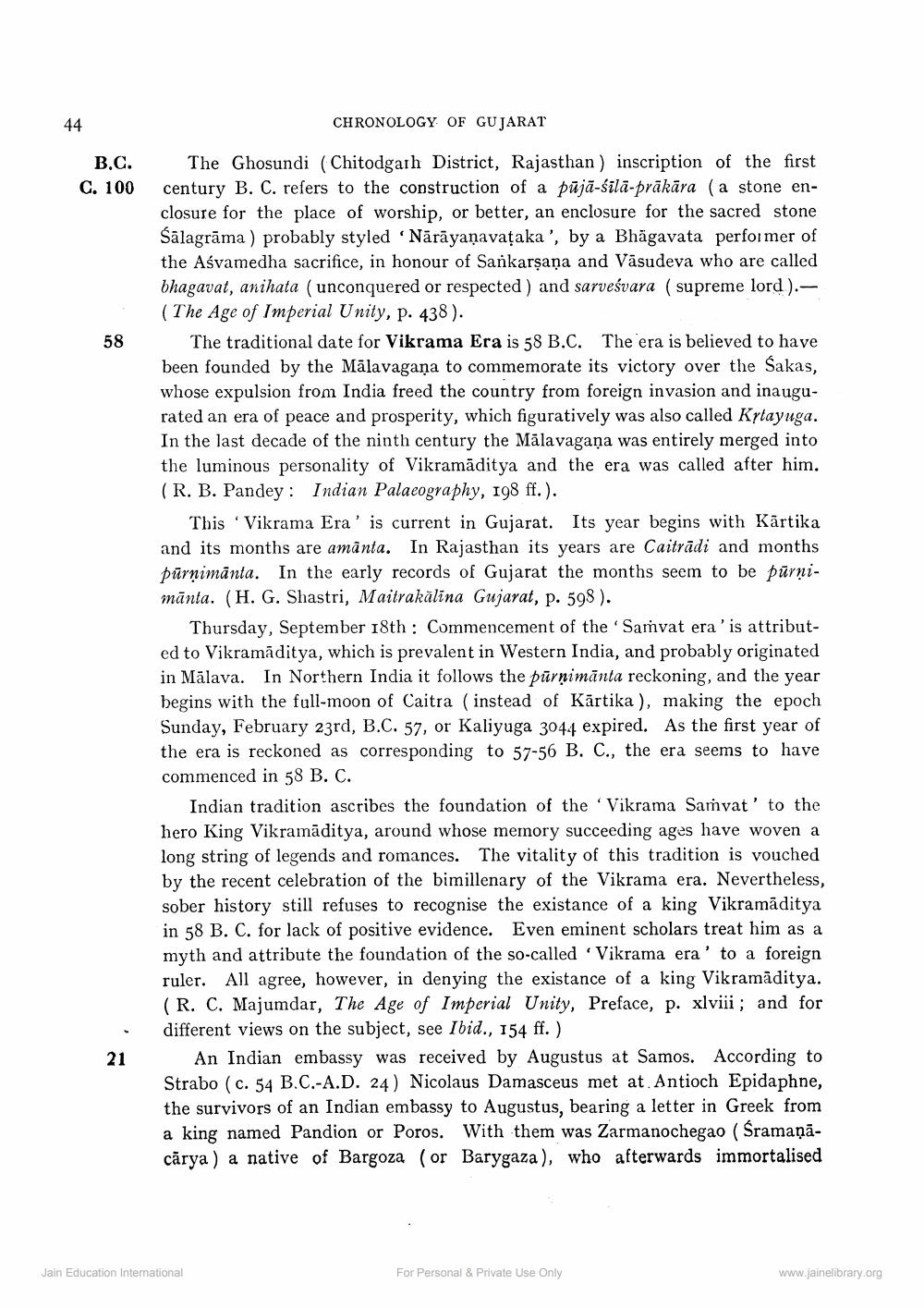________________
44
CHRONOLOGY OF GUJARAT
B.C. C. 100
The Ghosundi (Chitodgarh District, Rajasthan) inscription of the first century B. C. refers to the construction of a pājā-sila-prākāra (a stone enclosure for the place of worship, or better, an enclosure for the sacred stone Śālagrāma) probably styled 'Nārāyaṇavațaka', by a Bhagavata performer of the Aśvamedha sacrifice, in honour of Sankarşaņa and Väsudeva who are called bhagavat, anihata (unconquered or respected) and sarveśvara ( supreme lord). - (The Age of Imperial Unity, p. 438).
The traditional date for Vikrama Era is 58 B.C. The era is believed to have been founded by the Mālavagaņa to commemorate its victory over the Šakas, whose expulsion from India freed the country from foreign invasion and inaugurated an era of peace and prosperity, which figuratively was also called Kytayuga. In the last decade of the ninth century the Mālavagana was entirely merged into the luminous personality of Vikramāditya and the era was called after him. (R. B. Pandey : Indian Palaeography, 198 ff.).
This Vikrama Era' is current in Gujarat. Its year begins with Kārtika and its months are amânta. In Rajasthan its years are Caitrādi and months pūrnimānta. In the early records of Gujarat the months seem to be pārņimānta. (H. G. Shastri, Maitrakālīna Gujarat, p. 598).
Thursday, September 18th : Commencement of the Samvat era 'is attributed to Vikramāditya, which is prevalent in Western India, and probably originated in Mālava. In Northern India it follows the pūrņimānta reckoning, and the year begins with the full-moon of Caitra (instead of Kārtika), making the epoch Sunday, February 23rd, B.C. 57, or Kaliyuga 3044 expired. As the first year of the era is reckoned as corresponding to 57-56 B. C., the era seems to have commenced in 58 B. C.
Indian tradition ascribes the foundation of the Vikrama Samvat' to the hero King Vikramāditya, around whose memory succeeding ages have woven a long string of legends and romances. The vitality of this tradition is vouched by the recent celebration of the bimillenary of the Vikrama era. Nevertheless, sober history still refuses to recognise the existance of a king Vikramaditya in 58 B. C. for lack of positive evidence. Even eminent scholars treat him as a myth and attribute the foundation of the so-called Vikrama era' to a foreign ruler. All agree, however, in denying the existance of a king Vikramāditya. (R. C. Majumdar, The Age of Imperial Unity, Preface, p. xlviii; and for different views on the subject, see Ibid., 154 ff.)
An Indian embassy was received by Augustus at Samos. According to Strabo (c. 54 B.C.-A.D. 24) Nicolaus Damasceus met at Antioch Epidaphne, the survivors of an Indian embassy to Augustus, bearing a letter in Greek from a king named Pandion or Poros. With them was Zarmanochegao (Sramaņācārya) a native of Bargoza (or Barygaza), who afterwards immortalised
21
Jain Education Intemational
For Personal & Private Use Only
www.jainelibrary.org




